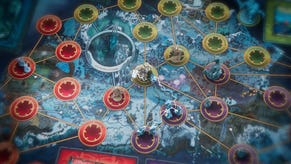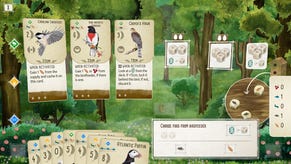How to play Pandemic: board game’s rules, setup and how to win explained
Going viral.
Although Pandemic wasn’t the first tabletop game to allow players to work together for a common cause, it’s maybe the best-known and most popular co-op board game out there today. With good reason - it’s a thrilling, thematic and just challenging enough experience that’s relatively easy to learn how to play and offer hours of interesting decisions without being overwhelming if you’re a board game beginner.
How to play Pandemic
- Player count, game length and overview: How many people can play Pandemic, how long Pandemic takes to play and what you'll be doing during the board game.
- Setup: Set up Pandemic's board, choose player roles, infect your first cities and prepare epidemic cards.
- Gameplay rules: Available player actions, how to cure diseases, when to draw cards and how to resolve episdemics and outbreaks.
- End of the game and how to win: How to win Pandemic - and how to avoid losing.
Matt Leacock’s 2008 game has been followed by a number of expansions and spin-offs in the decade-plus since - most notably the acclaimed Pandemic Legacy trilogy - but the original remains a great place to start if you’re looking to learn the basics. Once you know the rules of Pandemic, it’s easy enough to move onto some of the series’ other offerings and feel at home while enjoying the extra gameplay challenges and alternate scenarios they introduce.
To help get you started, this guide will run you through all of the rules for the original game, teaching you how to play Pandemic from setup and what you’ll be doing on each turn to how to win. It’s time to save the world together.
Player count, game length and overview
Pandemic is a co-operative board game for two to four players in which you all work together to tackle a number of infectious diseases and try to cure them before they get out of control. It takes around 45 minutes to play.
Setup
Unfold and lay out the board in the middle of the table so all players can reach it.
Separate the disease cubes into their four colours and lay them to the side of the board.
Place one research station in Atlanta and put the rest to the side.
Place your outbreak and cure markers on the board in their respective spots.
The outbreak marker is the green token that has the circle in the middle and the arrows pointing outwards. Place this on the 0 space of the outbreaks track.
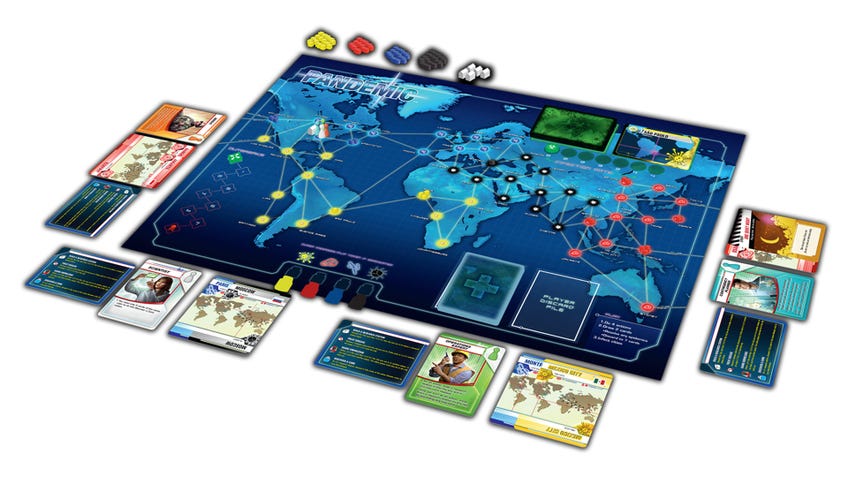
The cure markers are the vial-shaped pieces that match the colours of the four diseases in the game. Place these, vial side up, near the discovered cure indicator. Be sure not to place them on the actual spots just yet.
Place the infection rate marker - the green marker with the biohazard symbol on it - on the bottom of the infection rate track above the number 2.
Infecting cities
Now you’ll need to infect cities. You do this by flipping over the top three cards of the infection deck and placing three cubes of each card’s colour in the cities indicated. You then flip over three more cards and infect each city with two cubes. Finally you flip over three more cards and infect each city with one cube each. This means you’ll have a total of 18 cubes on the board before the game begins. Each of the city cards you’ve drawn during the infection step should go face up in the discard pile next to the draw pile.
Player roles
Next you each get your player cards. Each player should have a double-sided reference card which will remind you of the possible actions you can take on your turn.
Your role is chosen at random by shuffling the role cards together and dealing one to each player - although a common house rule is allowing players to choose their roles themselves.
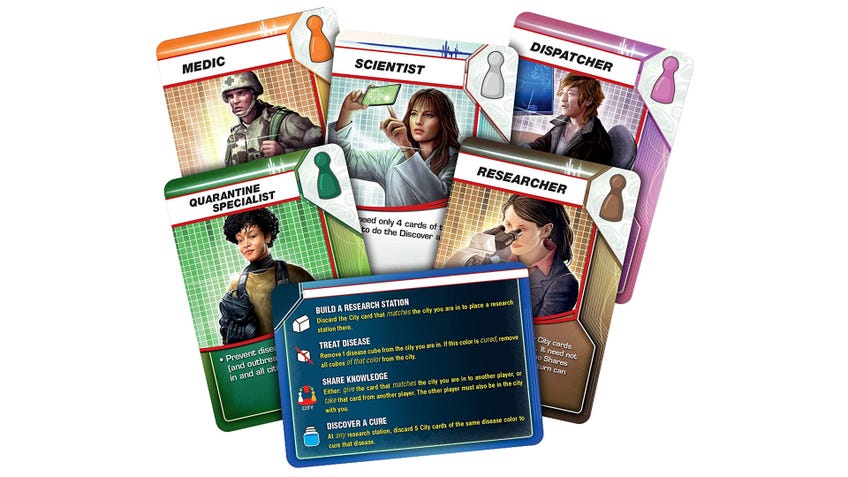
Make sure you read the text on your role card as every player has a unique ability that will help you during the game. The powers are written on each individual role card as well as the back of the rulebook.
Grab the pawn that matches your role card and place all the player pawns being used in this game in Atlanta. (Players always start at the Centre for Disease Control and Prevention in Atlanta.)
Player cards and hand limit
Remove the epidemic cards from the player deck, shuffle the player deck and deal cards to each player: four each in a two-player game, three each with three people and two each with the maximum four players. You can either keep these cards to yourself or play with an open hand - as it’s a co-op game you should have nothing to hide.
Throughout the game you will receive more cards, if you ever have more than seven cards in your hand, you’ll need to discard cards until you get down to the hand limit. You can use event cards to reduce your hand size.
Prepare epidemic cards and infection deck
You can alter the difficulty of Pandemic depending on the number of epidemic cards you include in the player deck: from four for an introductory beginner game up to six for experienced players. The more epidemic cards you include, the harder it’ll be to win.
Cut the player deck into separate piles of roughly the same size. (You don’t have to be exact.) You need to have as many piles as epidemic cards you’re going to use - for example, if this is your first game and you’re using four epidemic cards, make four piles.
Add an epidemic card to each pile and shuffle before placing the piles on top of each other to make one single player deck. Smaller piles should go toward the bottom, with thicker stacks at the top. This should spread the epidemic cards out somewhat evenly.
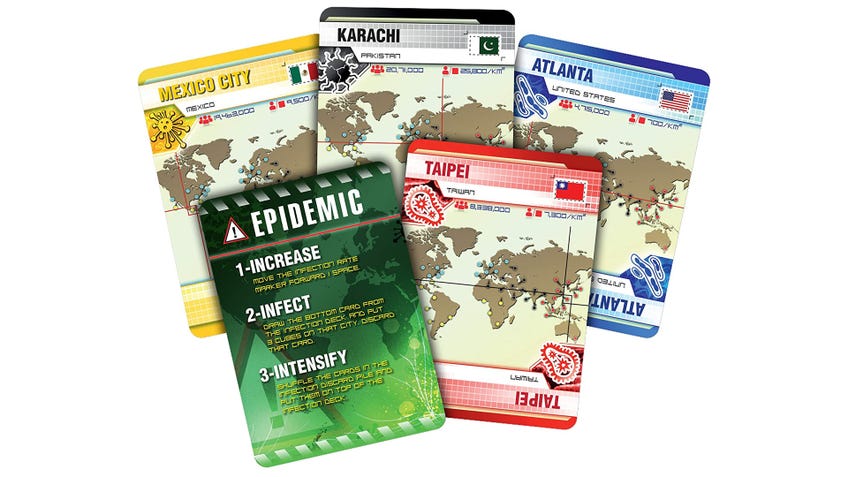
Gameplay rules
Let’s start playing! The player with the highest-population city card in their hand goes first.
Each player’s turn is split into three phases:
- Player actions
- Draw player deck cards
- Infect cities
1. Player actions
On your turn you can perform four actions. You have a total of eight possible actions to choose from. Your reference card will remind you throughout the game as to the actions you can perform. You can perform the same action more than once.
Drive/Ferry is the most basic move action. It allows you to move from one city to an adjacent location connected to it by a white line.
Direct Flight means you can move to a city named on a card by discarding the matching card from your hand.
Charter Flight is similar to Direct Flight, except you discard the card of the city you are currently in to travel to any other city on the map.
Shuttle Flight allows you to move between research stations once you have more than one on the board.
You can Build a Research Station by discarding the card matching the city you are in, Place a white research station marker in that city. If you have already placed all six research station markers from the box, you may choose to move an existing one on the board.
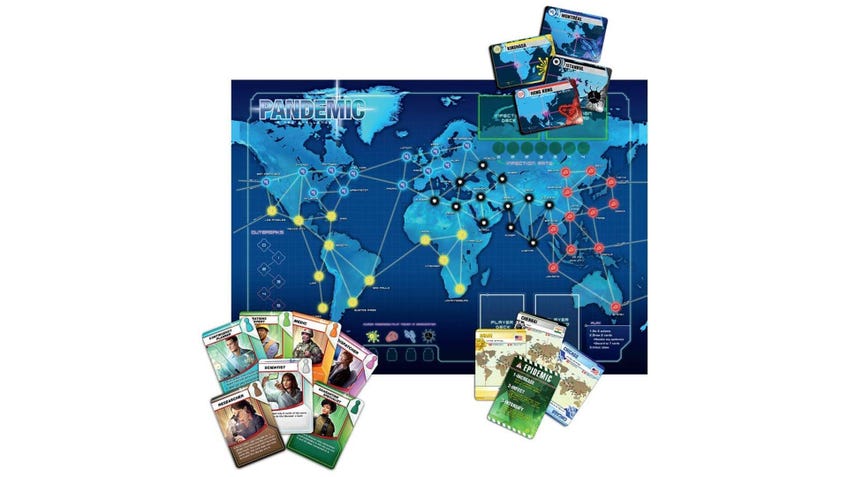
Treat Disease is one of the actions you’ll perform the most. Each Treat Disease action allows you to remove one disease cube from the city you are currently in. If a cure has been discovered for that disease, you can remove all of the cubes of that colour from the city as a single action.
The Share Knowledge action can be done in two ways:
- Give a city card to another player. In order to do this you both need to be in the city matching the card that you wish to give.
- Take a city card from another player. Again, you both need to be in the city matching the card you wish to take.
If, while sharing knowledge, one player has more than seven cards they will need to immediately discard down to seven or play an event card to reduce to the hand limit.
Last but certainly not least, you can Discover a Cure. To Discover a Cure, you’ll need to get your player pawn to a research station and discard five player cards of the same colour to cure the disease of that colour. Place that disease’s cure marker on its cure indicator on the board.
Once there are no cubes of a cured disease left on the board, that disease is eradicated. Flip the vial over to show the eradicated symbol. Eradicated diseases do not place new cubes on the board when revealed during the Infect Cities step.

2. Draw player deck cards
Once you have performed your actions, you’ll get to draw two cards from the player deck. The player deck contains city cards, event cards and the dreaded epidemic cards.
City cards are ultimately what will help you discover cures. You’ll be trying to get city cards of the same colour so you can discover cures as quickly as possible and win the game.
Event cards are rare and can be very powerful. They can be played by any player at any time and can save you from some dire situations. The only time they can’t be played is in-between drawing and resolving a card. For example, you can’t reveal an epidemic card and then play an event card - you must resolve the epidemic card in full first.
Epidemic cards are the main threat in Pandemic, as they spread disease and make your task harder. Resolving epidemic cards works as follows:
- Increase the infection rate by one by moving the marker to the next space on the infection rate track.
- Infect a new city by drawing the bottom card from the infection deck and place three cubes in that city.
- Now you intensify, which means taking the infection deck discard pile and shuffling it before placing it back on top of the infection draw deck. You’re now going to be drawing already infected cities again.
In the rare case that you draw two epidemic cards at once, you go through these steps once and then do them all again separately.
When you draw epidemic cards during your player card draw phase, you do not get to draw replacement cards - they count towards your draw cards. Remove any epidemic cards from the game once they’ve been drawn and resolved.
3. Infect cities
The last step of each player’s turn is to infect more cities. To do this, flip over as many infection cards as the current infection rate indicates. This will increase with each epidemic card you draw.
Reveal each infection card one at a time, adding one cube to each matching city.

How do outbreaks work in Pandemic?
If that city already has three cubes of that colour, you don’t add any more cubes to that city. Instead, an outbreak occurs.
Move the outbreak marker to the next spot on the outbreak track. If you ever get to the last icon on the track - the space with the skull and crossbones - you immediately lose the game.
Instead of placing a disease cube in the city that has had the outbreak, place a cube of that colour on each city connected to the original city that had the outbreak. (This may mean you place a cube that doesn’t match the colour of a location, for example a red cube on a yellow city.)
If any of those cities already have three cubes of that colour present, another outbreak occurs. You’ll need to repeat the steps above, moving the outbreak marker again and placing cubes in every city connected to that one - and so on and so forth until the chain reaction comes to an end. However, you never have more than one outbreak in each city on a given turn.

End of the game and how to win
Pandemic ends as soon as players have found cures for all four diseases. (You do not need to eradicate any diseases to win.) Because it’s a co-op game, everyone wins!
While there is only one way to win the game, there are three ways to lose:
- If the outbreak marker reaches the last space on the outbreak track.
- If you need to place disease cubes but have run out of cubes of a certain colour.
- If you are unable to draw two cards during your player card draw phase because the player deck is empty.
If any of the above occur, all of the players immediately lose the game.




